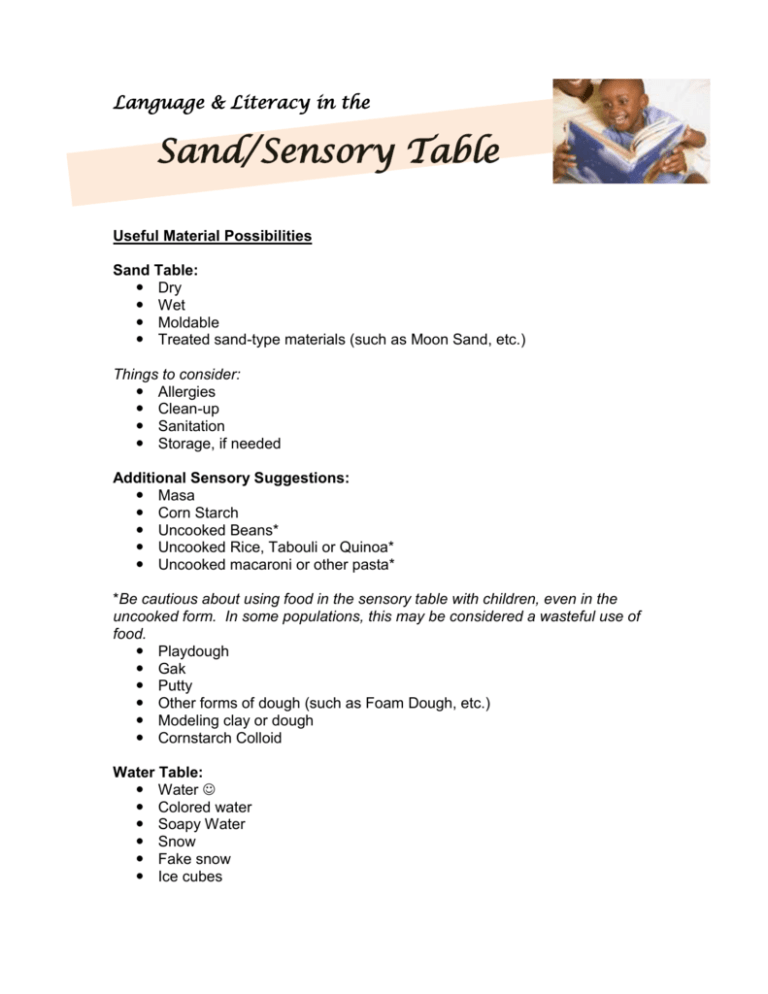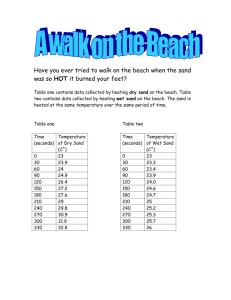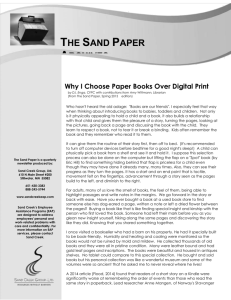Language & Literacy in the Useful Material Possibilities Sand Table
advertisement

Language & Literacy in the Sand/Sensory Table Useful Material Possibilities Sand Table: Dry Wet Moldable Treated sand-type materials (such as Moon Sand, etc.) Things to consider: Allergies Clean-up Sanitation Storage, if needed Additional Sensory Suggestions: Masa Corn Starch Uncooked Beans* Uncooked Rice, Tabouli or Quinoa* Uncooked macaroni or other pasta* *Be cautious about using food in the sensory table with children, even in the uncooked form. In some populations, this may be considered a wasteful use of food. Playdough Gak Putty Other forms of dough (such as Foam Dough, etc.) Modeling clay or dough Cornstarch Colloid Water Table: Water Colored water Soapy Water Snow Fake snow Ice cubes Things to consider: Sanitation Disposal Replenishment (when necessary) Language and Literacy Ideas Phonemic/Phonological Awareness: Constructing a model of a portion or object in a nursery rhyme (ex: Miss Muffett’s tuffet or bowl or curds and whey) Recreate nursery rhyme using materials and figures. Recite nursery rhyme using props Hide rhyming word pictures in dry sand. Find the matching pictures Build 2-3 items that begin with the same sound (ex: boy, ball, bat) Identify rhyming words in a short story or rhyme. Build one of the rhyming items After building a project out of materials, identify the beginning sound of the item(s) Letter Recognition: Hide letters of the alphabet in sand. Name each letter when it is found Hide magnetic letters in sand and find the letters using a magnet wand Form letters of the alphabet out of wet sand Form letters of the alphabet out of playdough Use alphabet cookie cutters with playdough or gak Draw alphabet shape in wet sand and fill with water Float foam letters in water, fish them out with tongs or ladle and name them Float magnetic letters in water and using a magnet attached to a string, fish out the letters and name them Float letters in water and using a ladle, fish out two letters that are next to each other in the alphabet Create letters of the alphabet using dry beans on a tray Recreate letters in the environment using molding materials Print Awareness: Create your favorite part of a story read Retell a story using props and materials in the sand or water table Read part of a story and then create a story ending using wet sand or playdough Listening Comprehension: Instead of asking questions, respond to a story by creating a favorite part of the story with wet sand or playdough Create three parts of a story in the sand table and indicate what came first, next and last With a partner, create parts of a story just read and use the creation to retell the story to others Create your own story using playdough and tell the story to a friend Create an additional part of a story using materials in the sand/water table Writing: Practice writing letters with your finger using a thin layer of sand on a tray Draw the alphabet letters with your finger in wet sand Create a self-portrait using playdough Using a large dropper or baster, write name with water on sand or colored paper Form letters of the alphabet using playdough or gak then write the letter on a paper with a crayon or pencil Oral Language: Explain the creation made in the sand table or playdough tray Explain the process that happens in the pouring center with water, snow or ice









